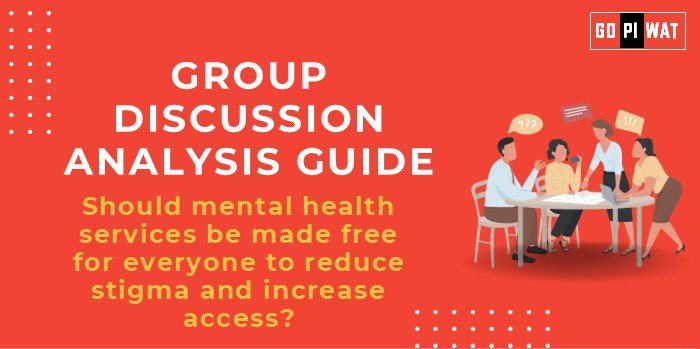📋 Group Discussion (GD) Analysis Guide: Should Mental Health Services Be Made Free for Everyone to Reduce Stigma and Increase Access?
🌐 Introduction to the Topic
Opening Context:
Mental health disorders affect over 1 billion people globally, yet stigma and cost barriers significantly hinder access to care. With rising awareness of mental health’s role in societal productivity and well-being, this topic is crucial for future business leaders to address.
Topic Background:
The movement to make mental health services free aligns with broader healthcare access reforms globally. Countries like the UK have included mental health under universal healthcare, while others grapple with stigma, workforce shortages, and funding gaps. In the Indian context, mental health accounts for less than 1% of public healthcare spending despite the National Mental Health Programme (NMHP) being in place.
📊 Quick Facts and Key Statistics
- 🌍 Global Burden: Depression and anxiety cost the global economy $1 trillion annually (WHO).
- 🛑 Access Gap: 76-85% of people with severe mental health conditions in low-income countries lack treatment.
- 🇮🇳 India’s Need: Suicide is the leading cause of death among 15-29-year-olds in India (NCRB, 2023).
- 💰 Economic Impact: Investment in mental health yields a $4 return for every $1 spent (WHO).
- 📉 Current Spending: Less than 1% of India’s health budget is allocated to mental health.
👥 Stakeholders and Their Roles
- 🏛️ Government: Policy frameworks, funding programs like NMHP.
- 🩺 Healthcare Providers: Delivering care, expanding mental health workforce.
- 🌍 NGOs and Activists: Raising awareness, reducing stigma, advocacy for policies.
- 🏢 Corporates: Workplace mental health initiatives, CSR funding.
- 🧍 Citizens: Advocating for their rights, destigmatizing mental health issues.
🏆 Achievements and Challenges
✨ Achievements:
- 📜 Policy Framework: Mental Healthcare Act 2017 ensures rights-based treatment.
- 📡 Telehealth Expansion: Platforms like e-Sanjeevani have bridged rural gaps.
- 🏢 CSR Role: Initiatives by firms like Tata and Wipro in workplace mental health.
⚠️ Challenges:
- 📊 Resource Gap: India has only 0.3 psychiatrists per 100,000 population (WHO benchmark: 3 per 100,000).
- 💬 Stigma: Cultural barriers impede open dialogue.
- 🏘️ Rural Disparity: Access to mental health professionals is highly urban-centric.
🌍 Global Comparisons:
- 🇬🇧 UK: National Health Service (NHS) offers free mental healthcare with targeted anti-stigma campaigns.
- 🇦🇺 Australia: Medicare covers mental health services, with additional funding for rural programs.
💬 Structured Arguments for Discussion
- ✔️ Supporting Stance: “Free mental health services can improve workforce productivity and social harmony, reducing the $1 trillion annual economic burden of untreated conditions.”
- ❌ Opposing Stance: “Free services might strain existing healthcare infrastructure without addressing critical supply gaps in professionals and facilities.”
- 🔄 Balanced Perspective: “While free services can democratize access, a phased approach with simultaneous investment in workforce training and infrastructure is critical for sustainability.”
🎯 Effective Discussion Approaches
🚀 Opening Approaches:
- 📊 Statistical Start: “With over 85% of Indians lacking access to mental health care, is cost-free service the panacea?”
- ⚖️ Contrast Approach: “India’s mental health spending is below 1%, whereas even small countries allocate more—can free services be a game changer?”
💡 Counter-Argument Handling:
- ✔️ Acknowledge Limitations: “Agreed, existing infrastructure is limited…”
- 🔧 Present Solutions: “…but telehealth and public-private partnerships can alleviate strain.”
🔍 Strategic Analysis of Strengths and Weaknesses
- 💪 Strengths: Removes financial barriers, promotes inclusivity, boosts societal productivity.
- ⚖️ Weaknesses: Financial strain on governments, potential overuse without awareness campaigns.
- 🌱 Opportunities: CSR partnerships, global funding for mental health.
- ⚠️ Threats: Persistent stigma, resistance from private providers.
🎓 Connecting with B-School Applications
🌐 Real-World Applications:
- 📈 CSR strategy: Tying mental health to workplace productivity.
- 💰 Financial modeling for healthcare initiatives.
🤔 Sample Interview Questions:
- ❓ “How would you address mental health access in resource-constrained environments?”
- ❓ “What role can technology play in expanding mental healthcare?”
💡 Insights for B-School Students:
- 🔍 Interdisciplinary approach: Finance, operations, and healthcare strategies.
- 📊 Focus on scalability of social-impact projects.


